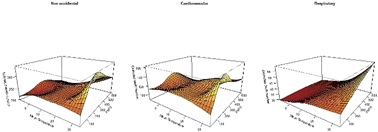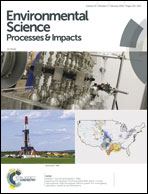The effects of interaction between particulate matter and temperature on mortality in Beijing, China†
Abstract
Background: the effects of interaction between temperature and inhalable particulate matter (aerodynamic diameter < 10 μm, PM10) on mortality have been examined in some previous studies, but the results were inconsistent. This study aims to explore whether the effects of PM10 on daily non-accidental, cardiovascular and respiratory mortality were modified by temperature levels in Beijing from 2006 to 2009. Methods: we applied a bivariate response surface model and temperature-stratified model based on time-series Poisson generalized additive models (GAMs) to examine the interactive effects in single- and two-pollutant models. The modification of age and gender was examined in subgroup analyses. Results: the median of temperature (15.9 °C) and visualized turning point (20 °C) were chosen as cut-offs to define the temperature strata as two levels (low and high). Results showed that the effect estimates of PM10 were stronger at the high temperature level for non-accidental, cardiovascular and respiratory mortality than at the low temperature level. When controlling the moving average lag of temperature for 14 days, the effect estimates per 10 μg m−3 increase in PM10 for non-accidental, cardiovascular and respiratory mortality increased 0.14% (95% CI: 0.05, 0.22), 0.12% (95% CI: 0.02, 0.23) and 0.14% (95% CI: −0.06, 0.34) when the temperature was low and 0.24% (95% CI: 0.12, 0.35), 0.17% (95% CI: 0.01, 0.34) and 0.45% (95% CI: 0.13, 0.78) at the high temperature level, respectively. In the two-pollutant model, the effects of PM10 were attenuated at both high and low temperatures at all lags after adjusting SO2 and NO2. The PM10 effects were stronger at the high temperature level for females and elderly people (≥65 years old). Conclusion: the findings suggest that daily mortality attributed to PM10 might be modified by temperature. The interaction between air pollution and global climate change has potential strategy and policy implications.



 Please wait while we load your content...
Please wait while we load your content...